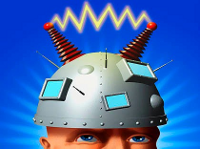Do You Want Your Computer to Read Your Mind?
 Hummmmm… IBM thinks that you do! They are predicting a technology (already under development) that will allow your computer (via a headset that you will wear) to “read your mind” and allow you to control the compouter! Sounds cool to me! Especially for gaming! Imagine moving your space craft in a game via mental instructions! I like it!
Hummmmm… IBM thinks that you do! They are predicting a technology (already under development) that will allow your computer (via a headset that you will wear) to “read your mind” and allow you to control the compouter! Sounds cool to me! Especially for gaming! Imagine moving your space craft in a game via mental instructions! I like it!
IBM: Mind-Reading Machines Will Change Our Lives
“In five years, we’ll simply be able to think something, and a computer will respond. That’s the vision from IBM, which just published its ‘5 in 5’ forecast, which attempts to predict five technologies that have the potential to significantly change our lives in the next five years. One of the more surprising candidates: machines that will read our thoughts.
Well, not exactly, IBM Senior Inventor Kevin Brown told Mashable. The idea is a little more down-to-earth — and less scary — than the science-fiction scenarios of mind-reading robots that the description evokes. IBM’s vision is this: a person wears a headset that can detect general electrical signals from the brain, and sends them to a computer. Sophisticated software interprets those signals and, in turn, tells a machine what to do.
‘One of the common misconceptions is that this headset is reading your thoughts,’ says Brown. ‘It’s not. It’s just reading a level of excitement. It’s not understanding.’
The technology behind the idea has existed for a while. The headset, which costs just $299 and is made by a company called Emotiv, is able to detect electrical signals in the brain (via electroencephalography, or EEG) as well as muscular movements (electromyography, or EMG), both well known in the medical community.
Once you have those signals, Brown says the real magic begins, which is the ability to map signals to different actions. By doing so, the user is effectively teaching the machine how to read a specific mind. In much the same way speech-recognition software gets tailored to an individual’s accent, inflections, and pronunciation, the mind-reading software can adapt to a person’s unique ‘thoughts.’
The next step is mapping specific thoughts to specific actions, analogous to programming a universal remote control. The key here is that the thought and action don’t necessarily have to be the same. For example, if you want to use the headset to, say, turn on a TV, you might program the headset to perform that action when you think about kittens.”